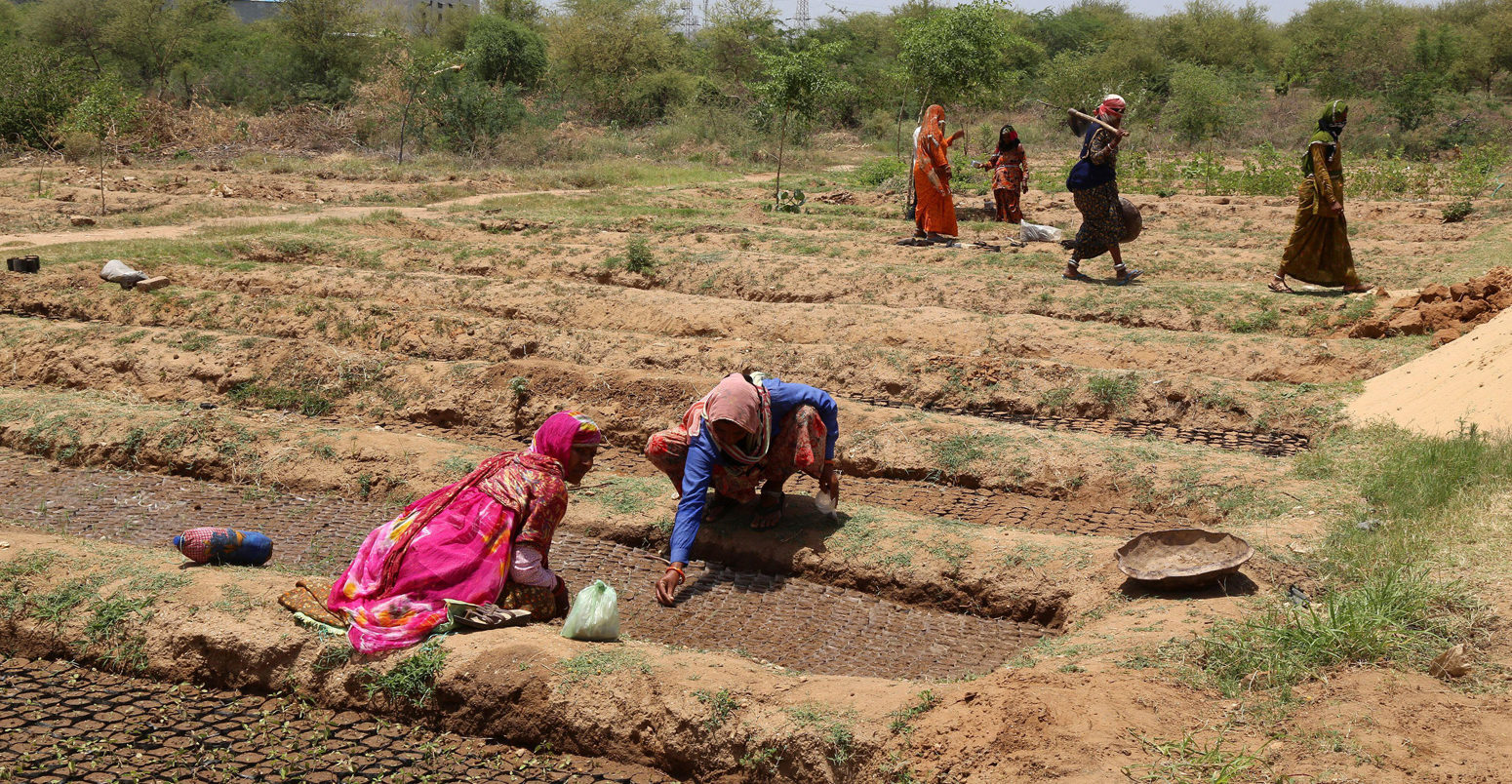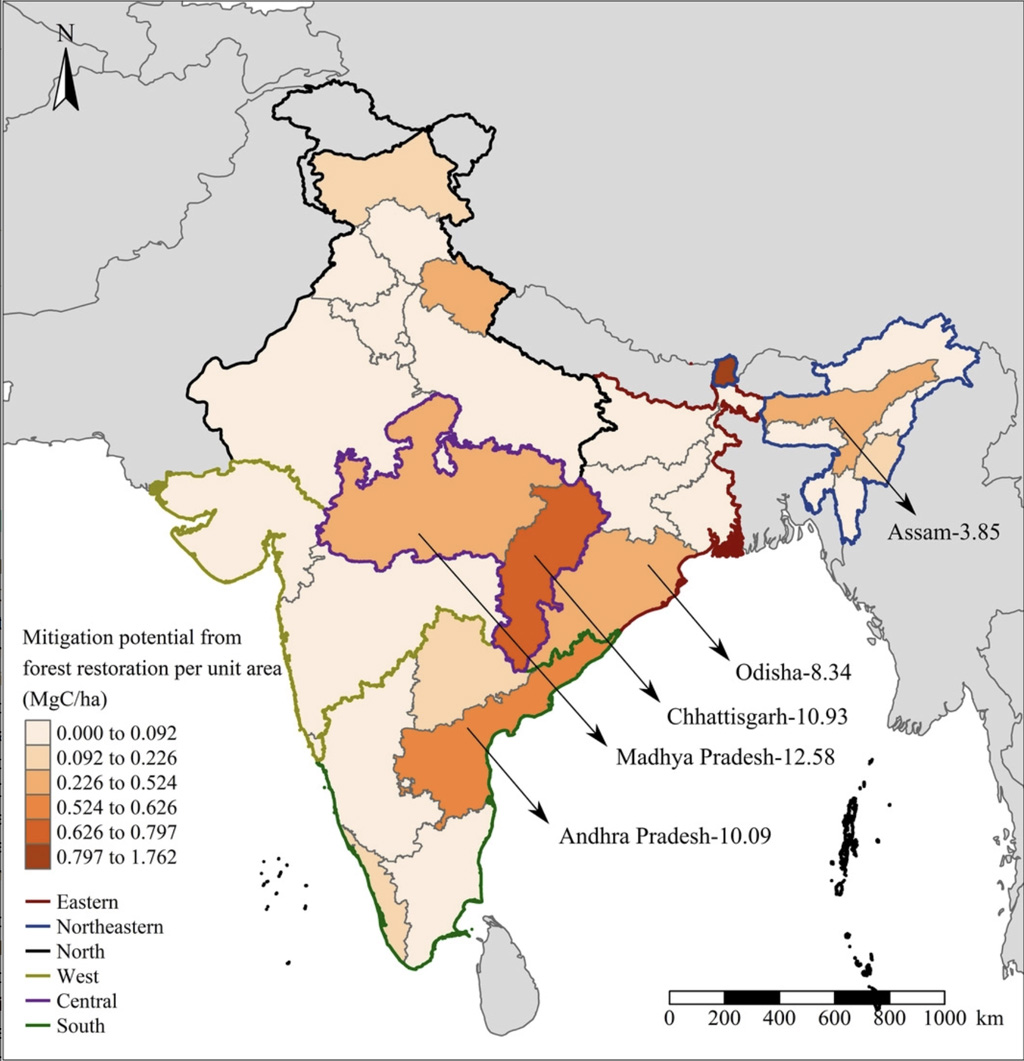
Guest post: How much could restoring forests reduce India’s emissions?

Guest author
02.17.22
Guest author
17.02.2022 | 11:29amIndia has made ambitious pledges to restore forests to tackle climate change, alongside many other countries. But what that goal looks like in practice is not yet well understood.
Our study, published in Conservation Letters, uses detailed spatial mapping to estimate how much land is available to be reforested in India, which regions would be most appropriate and how reforestation could contribute to meeting the country’s climate goals.
The reality looks quite different. Restoring forests on available land – that is, land not currently used for anything else – achieves only 10% of what India has pledged under the Paris Agreement.
Combining tree-planting with agriculture – known as agroforestry – can make a big difference. But the potential to reduce emissions would still only amount to less than a quarter of what India has pledged to achieve by 2030.
Why is India prioritising forest restoration?
Most pathways to meeting globally-agreed climate targets require restoration of forests to draw down carbon from the atmosphere. The pledge by 100 nations to “halt and reverse forest loss” by 2030 at COP26 in December was hailed as a landmark achievement on the road to limiting global warming to 1.5C.
Many countries have committed to restoring large areas to forests as part of their Nationally Determined Contributions. India aims to expand forest cover from 23% to 33% of its land area by 2030, creating an “additional (cumulative) carbon sink of 2.5-3bn tonnes of CO2-equivalent (GtCO2e)”.
A number of high-profile global analyses identify hundreds of millions of hectares of land globally on which forests could be restored. But what these pledges and assessments do not tend to address is that the land required is, in most cases, already used for something else.
In addition, these global estimates can overestimate the true potential of forest restoration by including areas that are ecologically inappropriate, such as natural grasslands and savannahs, and agricultural or pasture lands where forest restoration may endanger future food security.
Mapping India’s forest opportunity
In our study, we take a closer look at the opportunity to restore forests in India. India is the seventh largest country in the world, with a total area of 3.3m square kilometres (km2). Expanding forest cover by 10% of the country’s land area is, therefore, no small task.
We quantify how much land area in India is available to be reforested, where that opportunity is found and how much carbon sequestration it could really deliver. We focused on areas where natural forests can be sustained without compromising ecosystems or endangering food security.
The first challenge is that the climate of India is extremely diverse, and not all these climates are suitable for natural regeneration of forests.
We used a machine-learning framework to define a “bioclimatic envelope” of where forests in India could be sustained, using a variety of climatic, topographic and soil data as predictors.
While this has been carried out at a global scale before, our study is the first to do so in India using a dataset of more than 11,000 GPS-tagged points where the presence of forests had been verified on the ground.
Our analysis identifies just over 1m km2 of land across all of India that could support forests. After excluding the current forest area, this leaves 0.6m km2 of unforested land that could potentially support new forest cover.
However, this envelope does not account for the diversity of existing land uses in India. So, we then used a recent high-resolution national map of Indian land cover to exclude wetlands and native grasslands, woodlands and savannahs – all of which can harbour important biodiversity.
Of the amount of land that remained as potentially suitable for restoring natural forests, 74% is currently being used for agriculture – either to grow crops, raise livestock or to practise jhum (or “shifting agriculture”, a form of crop-growing predominantly practised in northeastern states).
Excluding land used for agriculture, as well as settlements and built-up areas, this left only 16,000 km2 of unused land in India that is immediately available for forest restoration – less than 0.5% of the country’s area.
If these areas could all naturally regenerate, we calculated that they could sequester about 61m tonnes of carbon (MtC) once mature – less than 10% of India’s 2030 pledge.
This land is also unevenly distributed across India. The map below shows the amount of carbon that could be drawn down in different Indian states per unit area of restored forest – known as the climate change “mitigation potential”. The darker the orange shading, the higher the mitigation potential. As the map shows, most of the opportunity to restore forests lies in a handful of states in the central and eastern parts of the country.

Forest restoration needs to consider existing land uses
Given that most of the apparent opportunity for restoring forests in India lies on land that is currently used for agriculture, agroforestry is one possible solution.
Agroforestry is the practice of integrating trees into crop and livestock agricultural systems and has been widely promoted in India as a way of supporting farmers’ livelihoods as well as improving environmental quality. India was the first country in the world to adopt a National Agroforestry Policy in 2014.
We estimated how much carbon could be stored if all the farmland within the forest envelope were converted to agroforestry, using data from real agroforestry systems practised across India. We calculated that agroforestry could draw down an additional 98MtC from the atmosphere cumulatively – more, in fact, than restoring forests alone.
This can only be a rough estimate at this scale. Agroforestry encompasses an enormous variety of different agricultural systems, containing different levels and types of tree cover, and each of these would store different amounts of carbon. However, it’s enough to illustrate the scale of contribution that agroforestry could make.
Putting the two together, that adds up to an additional 159MtC drawn out of the atmosphere from restoring forests and expanding agroforestry in India. This is still less than one quarter of the 2.5-3 GtCO2 – equivalent to 700-800Mt of carbon – that the government has pledged by 2030.
Making progress
Our study underscores the complexity of changing land use on a large scale. Specifically, we find that global estimates tend to overestimate climate change mitigation potential, particularly in countries with large agricultural holdings. Our analysis also highlights the importance of local land-use information.
Our findings suggest that forest restoration can only be one of many strategies fundamental to India meeting the goals of the Paris Agreement and that substantial greenhouse gas emission reductions will be needed by other sectors, most importantly energy.
Above all, our study emphasises that India’s climate goals require forest restoration strategies that work with existing land uses and the people who live and rely on that land, rather than replacing them.
Moving ahead, we recommend that researchers and governments focus not only on the total area available for forest restoration and agroforestry, but also social and cultural dimensions. These include forest governance, land tenure issues, historical land use legacies and approaches that can reconcile environmental goals with the needs of existing land users.
Gopalakrishna, T. et al. (2022) Existing land uses constrain climate change mitigation potential of forest restoration in India, Conservation Letters, doi:10.1111/conl.12867

